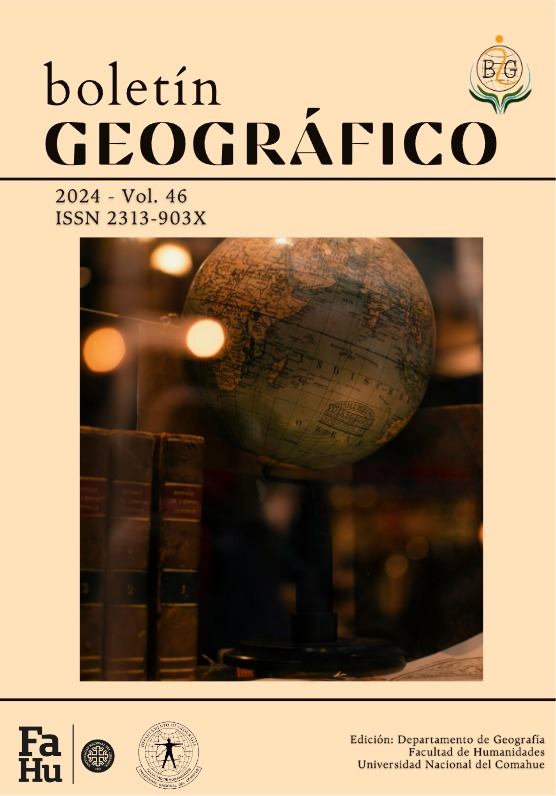Comparative flood mapping using SAR images: the Santa Lucía river case
Keywords:
flooded plain, mechanisms of interaction, land-use planning, remote sensingAbstract
Floods are among the most frequent and widespread hazards worldwide. An increase in flood events is anticipated due to population growth in exposed areas, economic growth and climate change (Rojas et al., 2022). This study aims to compare the capabilities of C- and L-band synthetic aperture radar (SAR) images for flood mapping. This approach provides insight into the conservation of river wetlands and contributes to land use planning by minimizing urban development in areas prone to frequent flooding. To achieve this, maps depicting changes in the σ0 coefficient were generated using SAR images captured at two frequencies: C-Band and L-Band, under both flood and non-flood conditions. Subsequently, dominant interaction mechanisms between the backscatter coefficient σ0 and the existing vegetation were analyzed. combined with statistical criteria, the analyses facilitated the generation of flood maps. Ground truth points reflecting flood extent as reported by local residents and previously conducted flood mapping in the area demonstrated the superior performance of the L-Band in detecting flood extent. However, both systems showed significant sensitivity to flood conditions.
Downloads
References
Arnesen, A.S., Silva, T.S.F., Hess, L.L., Novo, E.M.L.M., Rudorff, C.M., Chapman, B.D., McDonald, K.C. (2013) Monitoring flood extent in the lower Amazon River floodplain using ALOS/PALSAR ScanSAR images. Remote Sensing of Environment, 130: 52-61.
Berezowski, T., Bielinski, T. & Series Using River Gauge Observations. (2020) IEEE Journal of Selected Topics in Applied Earth Observations and Remote Sensing 13: 2626-2638.
Bruniard, E. D. (1966) Bases Fisiográficas para una división regional de la provincia de Corrientes. Resistencia, Chaco: Revista Nordeste, 8, 7–80..
Carnevali, R. (1994) Fitogeografía de la Provincia de Corrientes. Provincia de Corrientes - República Argentina: Gobierno de la Provincia de Corrientes - Instituto Nacional de Tecnología Agropecuaria.
Currie, H. M., & Gimenez, J. E. (1998), Las Cuencas Hídricas de la Provincia de Corrientes potencial y recursos (recopilación). Corrientes: Cátedra de Hidrología Agricola Facultad de Ciencias Agrarias - UNNE,.
Delgado Noguera, J. G. (2019). Zonificación del riesgo por inundación como aporte a la prevención, en el puerto - Laguna de la Cocha- Colombia. Revista Novedades Colombianas, 14(1), 27–47. https://doi.org/10.47374/novcol.2019.v14.1432
Donezar-Hoyos, U.; Larrañaga Urien, A.; Tamés-Noriega, A.; Sánchez-Gil, C.; Albizua-Huarte, L.; Ciriza-Labiano, R.,& Del Barrio-Arellano, F. (2017). Aplicación de imágenes Sentinel-1 y Sentinel-2 en la detección y delineación de información de crisis de desastres naturales en el marco de los servicios Copernicus EMS. Revista de Teledetección. (50):49-57. https://doi.org/10.4995/raet.2017.8896
Grings, F. M. (2008) Extracción de información ambiental a partir de imágenes de radar utilizando modelos de interacción onda-blanco. Universidad de Buenos Aires: Tesis doctoral.
Grings, F., Ferrazzoli, P., Jacobo-berlles, J., Karszenbaum, H., Tiffenberg, J., Pratolongo, P. & Kandus, P. (2006). Monitoring flood condition in marshes using EM models and Envisat ASAR observations. IEEE Transactions on. Geoscience and Remote Sensing, 44. 936 - 942. 10.1109/TGRS.2005.863482.
Henry, J. B. (2006). Envisat multi-polarized ASAR data for flood mapping. International Journal of Remote Sensing, 10(27), 1921-1929.
Hess, L. L., Melack, J. M., Filoso, S., & Wang, Y. (1995). Delineation of inundated area and vegetation along the Amazon floodplain with the SIR-C synthetic aperture radar. IEEE Transactions on Geoscience and Remote Sensing, 33(4).
Hess, L. L., Melack, J. M., & Simonett, D. S. (1990). Radar detection of flooding beneath the forest canopy: A review. International Journal of Remote Sensing, 11(7), 1313-1325.
Liu, Z., Zhao, L., Xu, T., Bu, F., Liu, X., & Zhou, D. (2018). Quantification of potential flood inundation areas in the marsh wetland of Honghe National Natural Reserve, Northeast China. Ecohydrology & Hydrobiology, 18(4), 355-364.
Mas, F. M. (2013). Las riberas fluviales. Ambienta, 90-101.
Munizaga, J., Garcia, M., Ureta, F., Novoa, V., Rojas, O., & Rojas, C. (2022). Mapping coastal wetlands using satellite imagery and machine learning in a highly urbanized landscape. Sustainability, 14, 5700.
Odriozola, M. P., & Contreras, F. I. (2018). Cartografías de riesgos de inundaciones y anegamientos en la provincia de Corrientes (Argentina). Universidad de San Martín: UNSAM.
Oliver, C., & Quegan, S. (2004). Understanding synthetic aperture radar images. SciTech Publishing.
Pattison, J. K. W., Pomeroy, J. W., Badiou, P., & Gabor, S. (2018). Wetlands, flood control, and ecosystem services in the Smith Creek drainage basin: A case study in Saskatchewan, Canada. Ecological Economics, 147, 36-47.
Pérez Morales, A. (2012). Estado actual de la cartografía de los riesgos de inundación y su aplicación en la ordenación del territorio: El caso de la región de Murcia. Boletín de la Asociación de Geógrafos Españoles, (58), 57-81.
Pope, K. O., Rejmankova, E., Paris, F. F., & Woodruff, R. (1997). Detecting seasonal flooding cycles in marshes of the Yucatan Peninsula with SIR-C polarimetric radar imagery. Remote Sensing of Environment, 157-166.
Pope, K. O., Rey Benayas, J. M., & Paris, J. F. (1994). Radar remote sensing of forest and wetland ecosystems in the Central American tropics. Remote Sensing of Environment, 48, 205-219.
Rahman, R. M., & Thakur, P. K. (2018). Detecting, mapping, and analyzing flood water propagation using synthetic aperture radar (SAR) satellite data and GIS: A case study from the Kendrapara District of Orissa State of India. The Egyptian Journal of Remote Sensing and Space Sciences, 21, 37-41.
Rojas, O., Soto, E., Rojas, C., & López, J. J. (2022). Assessment of the flood mitigation ecosystem service in a coastal wetland and potential impact of future urban development in Chile. Habitat International, 123.
Salvia, M. M. (2010). Aporte de la teledetección al estudio del funcionamiento del macrosistema Delta del Paraná: Análisis de series de tiempo y eventos extremos. Biblioteca Digital-Facultad de Ciencias Exactas y Naturales, Universidad de Buenos Aires.
San Martín, L., Morandeira, N., Grimson, R., & Kandus, P. (2015). Uso de imágenes ALOS/PALSAR-1 para la clasificación e inventario de humedales en la Llanura Costera de Ajó (Buenos Aires, Argentina). Teledetección: Humedales y Espacios Protegidos, XVI Congreso de la Asociación Española de Teledetección, 583-586.
Sánchez Sánchez, Y., Quirós, E., Durán Barroso, P., & Martínez Graña, A. (2019). Selección del umbral óptimo para la separación de la lámina de agua del embalse Jerte-Plasencia a partir de Sentinel-1. Teledetección: Hacia una visión global del cambio climático, 501-504.
Sevillano Rodriguez, M. E., Bravo Peña, L. C., Alatorre Cejudo, L. C., & Salcedo Hurtado, E. de J. (2020). Identificación de zonas de inundación a partir de imágenes (SAR) y de eventos históricos de inundación: Caso de estudio Santiago de Cali, Colombia. Cuadernos Geográficos, 59(2), 308-329.
Townsend, P. A., & Walsh, S. J. (1998). Modeling floodplain inundation using an integrated GIS with radar and optical remote sensing. Geomorphology, 21, 295-312.
Vich, A. J. (1996). Aguas continentales: Formas y procesos. Mendoza: Centro de Economía, Legislación y Administración del Agua.
Zozaya, A., & Del Pino, P. (2020). Design of an antenna array for an LFM-CW synthetic aperture radar prototype. DYNA, 87(212), 96-101.
Published
How to Cite
Issue
Section
ARK
License
Copyright (c) 2024 Boletín GeográficoTransfer of rights and data processing
The acceptance of an article for publication in the Journal Geographic Bulletin implies the cession of the rights of printing and reproduction, by any means and means, of the author in favor of the Department of Geography of the National University of Comahue, which will not reject any request reasonable for the authors to obtain permission to reproduce their contributions. The total or partial reproduction of the works published in the Geographic Bulletin must be done citing the origin, otherwise, the copyright is violated.
Likewise, it is understood that the concepts and opinions expressed in each work are the sole responsibility of the author, without being responsible or in solidarity, necessarily, neither the editorial staff nor the editorial staff.
It is the responsibility of the authors to be able to provide interested readers with copies of the raw data, procedure manuals, scores and, in general, relevant experimental material.
Likewise, the Management of the journal guarantees the appropriate treatment of personal data
COPYRIGHT TRANSFER FORM


















 Journal of the
Journal of the 